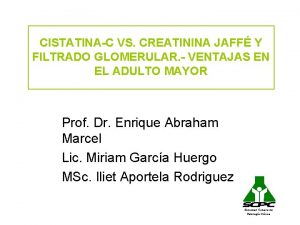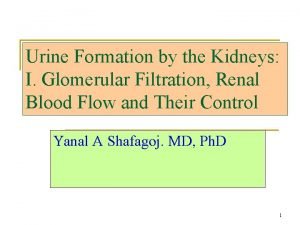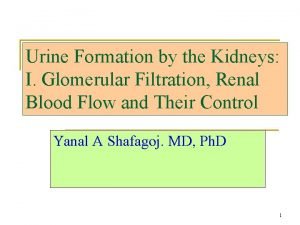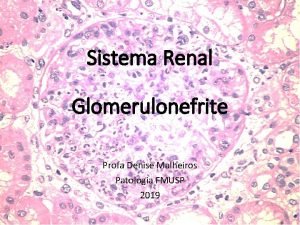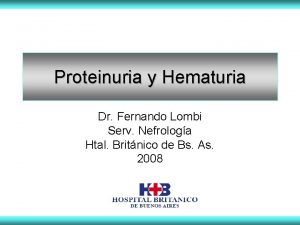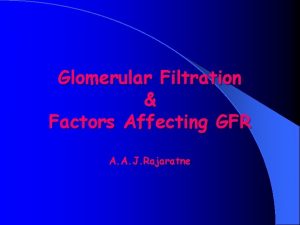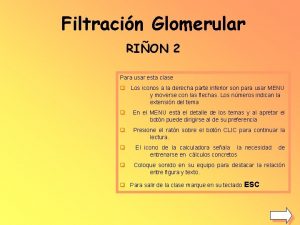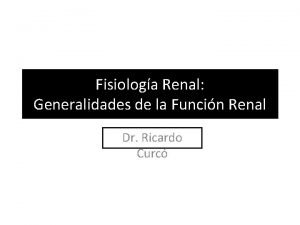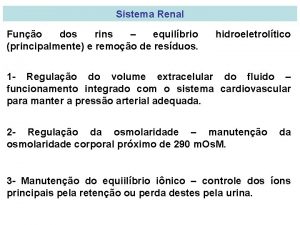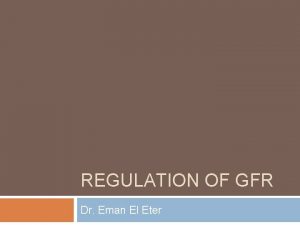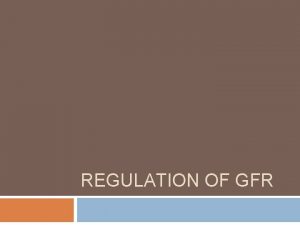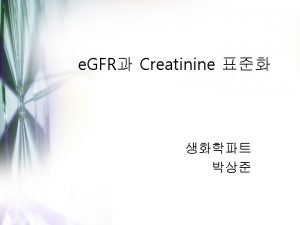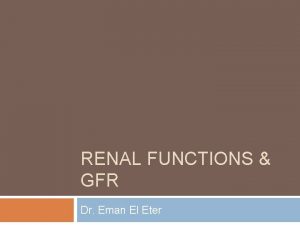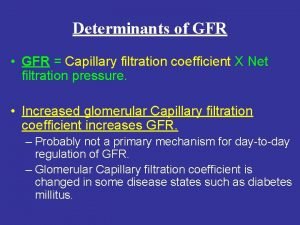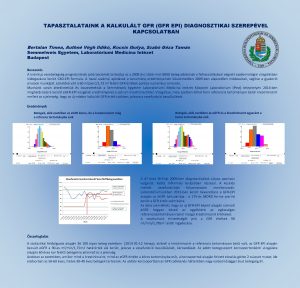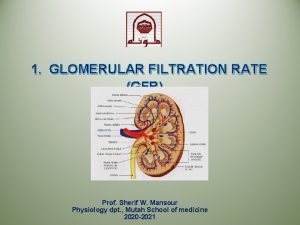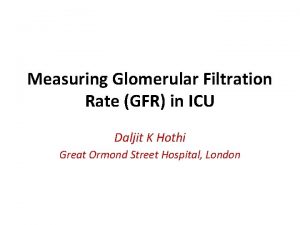REGULATION OF GFR Dr Eman El Eter Glomerular















- Slides: 15

REGULATION OF GFR Dr. Eman El Eter

Glomerular Filtration Rate (GFR) Defined as: The volume of filtrate produced by both kidneys per min Averages 125 ml/min Totals about 180 L/day (45 gallons) So most filtered water must be reabsorbed or death would ensue from water lost through urination GFR is directly proportional to the NFP An increase in NFP A decrease in NFP GFR Changes in GFR normally result from changes in glomerular blood pressure. NFP = net filtration pressure

Why is it important to have the GFR regulated?

Regulation of GFR Glomerular Filtration Rate If the GFR is too high: Fluid flows through tubules too rapidly to be absorbed Urine output rises Creates threat of dehydration and electrolyte depletion If the GFR is too low: Fluid flows sluggishly through tubules Tubules reabsorb wastes that should be eliminated Azotemia develops (high levels of nitrogencontaining substances in the blood).

Regulation of GFR controlled by adjusting glomerular blood pressure through the following mechanisms: - Autoregulation - Sympathetic control - Hormonal mechanism: renin and angiotensin

Autoregulation (intrinsic) It is the relative constancy of GFR and renal blood flow in response to changes in blood pressure range from 75 to 160 mm. Hg. That means in a normal kidneys, a decrease in arterial blood pressure as low as 75 mm. Hg, or an increase as high as 160 mm. Hg causes a change in GFR by only a few percentage. However, autoregulation is not perfect but it prevents potentially great changes in GFR , with changes in blood pressure, therefore, kidney continue to excrete waste.

Renal Autoregulation of GFR BP constrict afferent arteriole, & dilate efferent BP dilate afferent arteriole, & constrict efferent Stable for BP range of 75 to 160 mm. Hg (systolic) Cannot compensate for extreme BP changes

How autoregulation takes place?

Juxtaglomerular Apparatus -secrete Renin - monitor salinity

Mechanism of autoregulation Tubuloglomerular feedback mechanism: ABP delivery of Na. Cl to the macula densa cells, which are capable of sensing this change , this will cause two effects: 1 - a decrease in resistance of the afferent arterioles (i. e. vasodilatation) glomerular hydrostatic pressure to normal levels. 2 - An increase in renin release from JG cells Ang II constrict efferent arteriole glomerular hydrostatic pressure & GFR to

Mechanism of autoregulation, cont……. Myogenic mechanism: It is the intrinsic capability of blood vessels to constrict when blood pressure is increased. The constriction prevents excess increase in renal blood flow and GFR when blood pressure rises. When blood pressure decreases the myogenic mechanism reduces vascular resistance and the vessel dilates.

Example of autoregulation

Hormonal Control of GFR -efferent arterioles

Effects of Angiotensin II

Sympathetic Control of GFR (Extrinsic) When the sympathetic nervous system is at rest: Renal blood vessels are maximally dilated Autoregulation mechanisms prevail Under stress: Norepinephrine is released by the sympathetic nervous system Epinephrine is released by the adrenal medulla Afferent arterioles constrict and filtration is inhibited Note: during fight or flight blood is shunted away from kidneys The sympathetic nervous system also stimulates the renin-angiotensin mechanism. This induces vasoconstriction of efferent arteriole.
 Eman nayyab
Eman nayyab Eman güvenlik
Eman güvenlik Filtration pharmacology
Filtration pharmacology Filtrado glomerular formula korotkoff
Filtrado glomerular formula korotkoff Juxtaglomerular apparatus
Juxtaglomerular apparatus First order drug elimination
First order drug elimination Filtração glomerular fisiologia
Filtração glomerular fisiologia Arteriola aferente
Arteriola aferente Peritubular capillaries
Peritubular capillaries Glomerulo netter
Glomerulo netter Hematuria glomerular y extraglomerular
Hematuria glomerular y extraglomerular Factors influencing gfr
Factors influencing gfr Presión neta de filtración formula
Presión neta de filtración formula Filtracion renal
Filtracion renal Functions of glucagon
Functions of glucagon Pressão hidrostática capilar
Pressão hidrostática capilar



